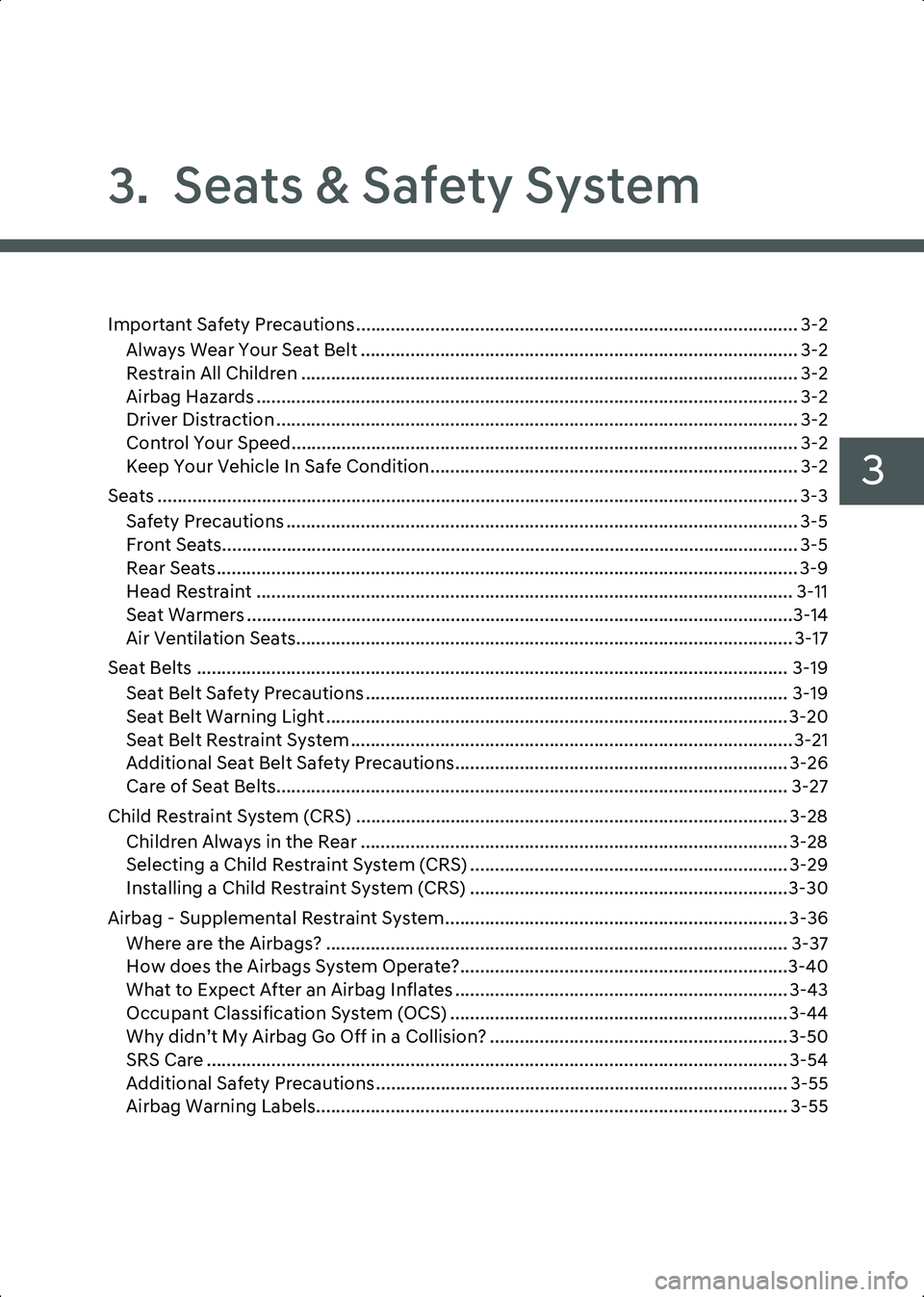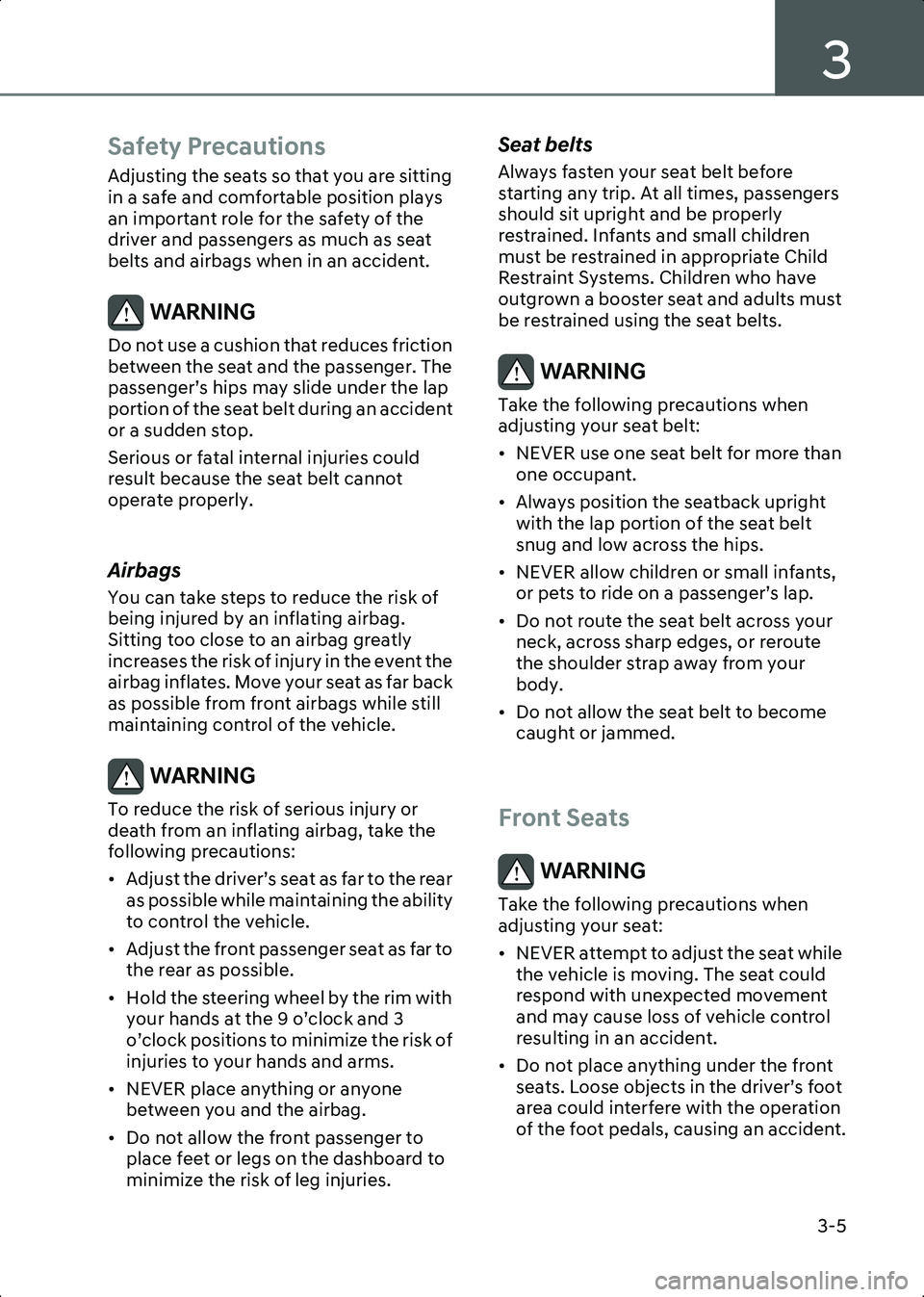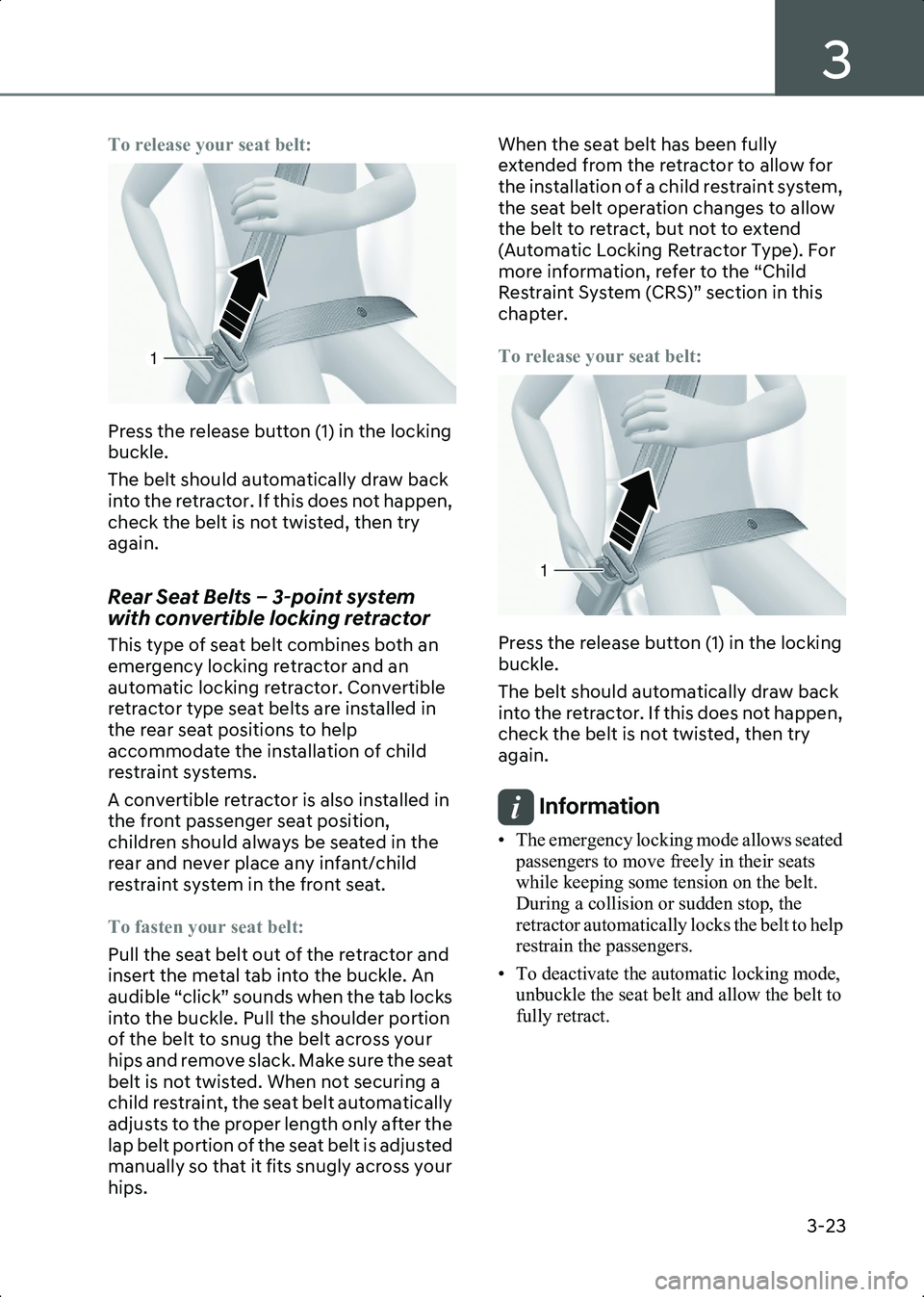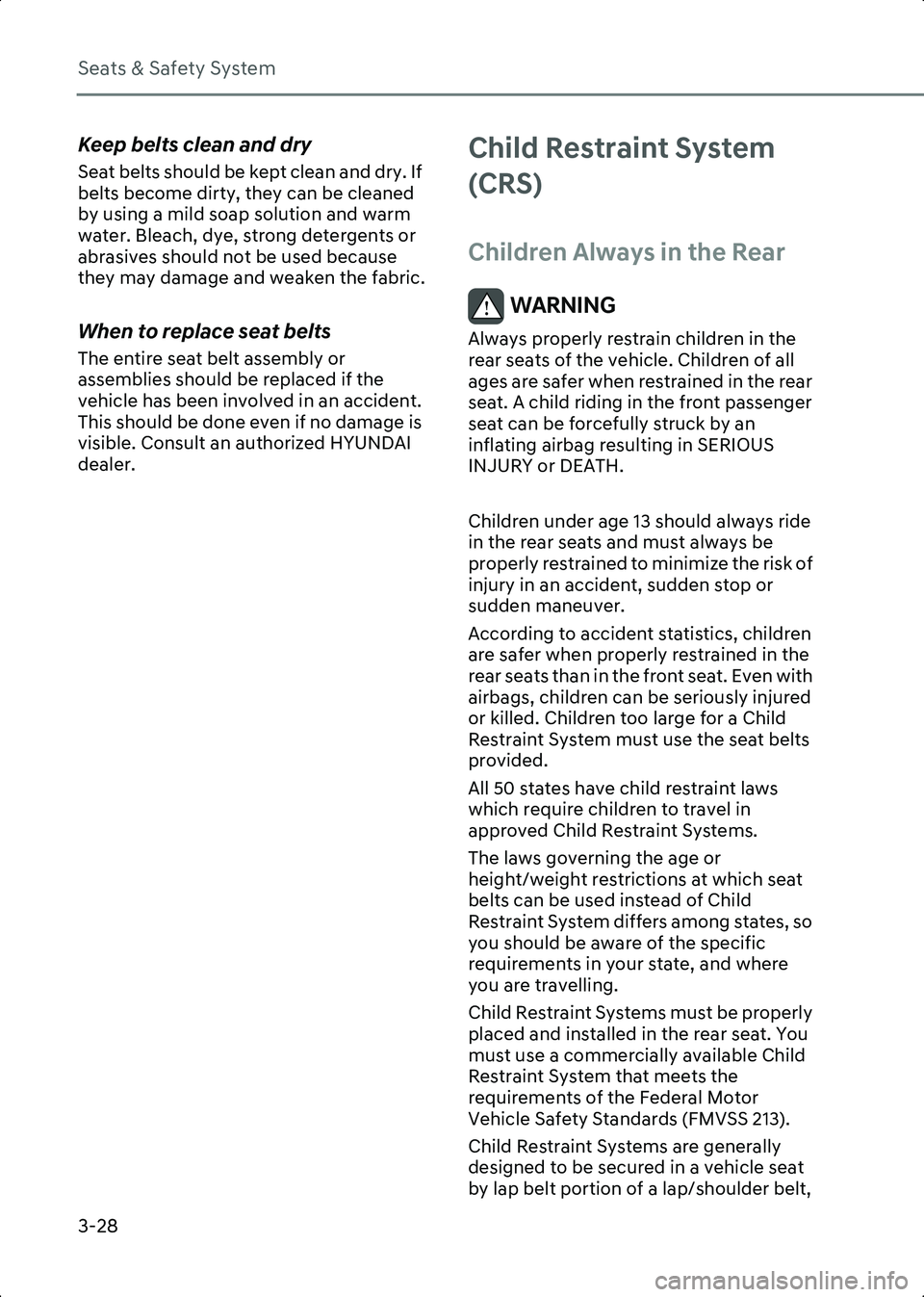2023 HYUNDAI IONIQ 6 child restraint
[x] Cancel search: child restraintPage 95 of 582

3
3. Seats & Safety System
Important Safety Precautions......................................................................................... 3-2Always Wear Your Seat Belt ........................................................................................ 3-2Restrain All Children .................................................................................................... 3-2
Airbag Hazards ............................................................................................................. 3-2
Driver Distraction ......................................................................................................... 3-2Control Your Speed...................................................................................................... 3-2Keep Your Vehicle In Safe Condition .......................................................................... 3-2
Seats ................................................................................................................................. 3-3 Safety Precautions ....................................................................................................... 3-5
Front Seats.................................................................................................................... 3-5Rear Seats ..................................................................................................................... 3-9
Head Restraint ............................................................................................................ 3-11
Seat Warmers ..............................................................................................................3-14
Air Ventilation Seats.................................................................................................... 3-17
Seat Belts ....................................................................................................................... 3-19 Seat Belt Safety Precautions ..................................................................................... 3-19
Seat Belt Warning Light ............................................................................................. 3-20
Seat Belt Restraint System ......................................................................................... 3-21
Additional Seat Belt Safety Precautions................................................................... 3-26
Care of Seat Belts....................................................................................................... 3-27
Child Restraint System (CRS) ....................................................................................... 3-28 Children Always in the Rear ...................................................................................... 3-28Selecting a Child Restraint System (CRS) ................................................................ 3-29
Installing a Child Restraint System (CRS) ................................................................3-30
Airbag - Supplemental Restraint System..................................................................... 3-36 Where are the Airbags? ............................................................................................. 3-37
How does the Airbags System Operate?..................................................................3-40
What to Expect After an Airbag Inflates ................................................................... 3-43
Occupant Classification System (OCS) .................................................................... 3-44
Why didn’t My Airbag Go Off in a Collision? ............................................................3-50
SRS Care ..................................................................................................................... 3-54
Additional Safety Precautions ................................................................................... 3-55
Airbag Warning Labels............................................................................................... 3-55
Hyundai_CE_en_US.book Page 1
Page 96 of 582

Seats & Safety System
3-2
Important Safety
Precautions
You will find many safety precautions and
recommendations throughout this
section, and throughout this manual. The
safety precautions in this section are
among the most important.
Always Wear Your Seat Belt
A seat belt is your best protection in all
types of accidents. Airbags are designed
to supplement seat belts, not to replace
them. So even though your vehicle is
equipped with airbags, always make sure
you and your passengers wear your seat
belts, and wear them properly.
Restrain All Children
All children under age 13 should ride in
your vehicle properly restrained in a rear
seat, not the front seat. Infants and small
children should be restrained in an
appropriate child restraint system. Larger
children should use a booster seat with
the lap/shoulder belt until they can use
the seat belt properly without a booster
seat.
Airbag Hazards
While airbags can save lives, they can also
cause serious or fatal injuries to
occupants who sit too close to them, or
who are not properly restrained. Infants,
young children, and short adults are at the
greatest risk of being injured by an
inflating airbag. Follow all instructions
and warnings in this manual.
Driver Distraction
Driver distraction presents a serious and
potentially deadly danger, especially for
inexperienced drivers. Safety should be
the primary concern when behind the
wheel and drivers need to be aware of the wide array of potential distractions, such
as drowsiness, reaching for objects,
eating, personal grooming, other
passengers, and using mobile phones.
Drivers can become distracted when they
take their eyes and attention off the road
or their hands off the wheel to focus on
activities other than driving. To reduce
your risk of distraction and an accident:
• Set up your mobile devices (for
example, mp3 players, phones,
navigation units, etc.) only when your
vehicle is parked or safely stopped.
• Only use your mobile device when allowed by laws and conditions permit
safe use. Never text or email while
driving. Most countries have laws
prohibiting drivers from texting. Some
countries and cities also prohibit
drivers from using handheld phones.
• Never let the use of a mobile device distract you from driving. You have a
responsibility to your passengers and
others on the road to always drive
safely with your hands on the wheel as
well as your eyes and attention on the
road.
Control Your Speed
Excessive speed is a major factor in crash
injuries and deaths. Generally, the higher
the speed the greater the risk, but serious
injuries can also occur at lower speeds.
Never drive faster than is safe for current
conditions regardless of the maximum
speed posted.
Keep Your Vehicle In Safe
Condition
Having a tire blowout or a mechanical
failure can be extremely hazardous. To
reduce the possibility of such problems,
check your tire pressures and condition
frequently and perform all regularly
scheduled maintenance.
Hyundai_CE_en_US.book Page 2
Page 99 of 582

3
3-5
Safety Precautions
Adjusting the seats so that you are sitting
in a safe and comfortable position plays
an important role for the safety of the
driver and passengers as much as seat
belts and airbags when in an accident.
WARNING Do not use a cushion that reduces friction
between the seat and the passenger. The
passenger’s hips may slide under the lap
portion of the seat belt during an accident
or a sudden stop.
Serious or fatal internal injuries could
result because the seat belt cannot
operate properly.
Airbags
You can take steps to reduce the risk of
being injured by an inflating airbag.
Sitting too close to an airbag greatly
increases the risk of injury in the event the
airbag inflates. Move your seat as far back
as possible from front airbags while still
maintaining control of the vehicle.
WARNING To reduce the risk of serious injury or
death from an inflating airbag, take the
following precautions:
• Adjust the driver’s seat as far to the rear as possible while maintaining the ability
to control the vehicle.
• Adjust the front passenger seat as far to the rear as possible.
• Hold the steering wheel by the rim with your hands at the 9 o’clock and 3
o’clock positions to minimize the risk of
injuries to your hands and arms.
• NEVER place anything or anyone between you and the airbag.
• Do not allow the front passenger to place feet or legs on the dashboard to
minimize the risk of leg injuries.
Seat belts
Always fasten your seat belt before
starting any trip. At all times, passengers
should sit upright and be properly
restrained. Infants and small children
must be restrained in appropriate Child
Restraint Systems. Children who have
outgrown a booster seat and adults must
be restrained using the seat belts.
WARNING Take the following precautions when
adjusting your seat belt:
• NEVER use one seat belt for more than one occupant.
• Always position the seatback upright with the lap portion of the seat belt
snug and low across the hips.
• NEVER allow children or small infants, or pets to ride on a passenger’s lap.
• Do not route the seat belt across your neck, across sharp edges, or reroute
the shoulder strap away from your
body.
• Do not allow the seat belt to become caught or jammed.
Front Seats
WARNING Take the following precautions when
adjusting your seat:
• NEVER attempt to adjust the seat while the vehicle is moving. The seat could
respond with unexpected movement
and may cause loss of vehicle control
resulting in an accident.
• Do not place anything under the front seats. Loose objects in the driver’s foot
area could interfere with the operation
of the foot pedals, causing an accident.
Hyundai_CE_en_US.book Page 5
Page 117 of 582

3
3-23
To release your seat belt:
B3001507
Press the release button (1) in the locking
buckle.
The belt should automatically draw back
into the retractor. If this does not happen,
check the belt is not twisted, then try
again.
Rear Seat Belts – 3-point system
with convertible locking retractor
This type of seat belt combines both an
emergency locking retractor and an
automatic locking retractor. Convertible
retractor type seat belts are installed in
the rear seat positions to help
accommodate the installation of child
restraint systems.
A convertible retractor is also installed in
the front passenger seat position,
children should always be seated in the
rear and never place any infant/child
restraint system in the front seat.
To fasten your seat belt:
Pull the seat belt out of the retractor and
insert the metal tab into the buckle. An
audible “click” sounds when the tab locks
into the buckle. Pull the shoulder portion
of the belt to snug the belt across your
hips and remove slack. Make sure the seat
belt is not twisted. When not securing a
child restraint, the seat belt automatically
adjusts to the proper length only after the
lap belt portion of the seat belt is adjusted
manually so that it fits snugly across your
hips.When the seat belt has been fully
extended from the retractor to allow for
the installation of a child restraint system,
the seat belt operation changes to allow
the belt to retract, but not to extend
(Automatic Locking Retractor Type). For
more information, refer to the “Child
Restraint System (CRS)” section in this
chapter.
To release your seat belt:
B3001507_1
Press the release button (1) in the locking
buckle.
The belt should automatically draw back
into the retractor. If this does not happen,
check the belt is not twisted, then try
again.
Information • The emergency locking mode allows seated
passengers to move freely in their seats
while keeping some tension on the belt.
During a collision or sudden stop, the
retractor automatically locks the belt to help
restrain the passengers.
• To deactivate the automatic locking mode, unbuckle the seat belt and allow the belt to
fully retract.
1
1
Hyundai_CE_en_US.book Page 23
Page 120 of 582

Seats & Safety System
3-26
Information • Pretensioner seat belts may be activated in certain frontal or side collisions or rollover
situations.
• When the pretensioner seat belts are activated, a loud noise may be heard and
fine dust, which may appear to be smoke,
may be visible in the passenger
compartment. These are normal operating
conditions and are not hazardous.
• Although it is non-toxic, the fine dust may cause skin irritation and should not be
inhaled for prolonged periods. Wash all
exposed skin areas thoroughly after an
accident in which the pretensioner seat belts
were activated.
Additional Seat Belt Safety
Precautions
Seat belt use during pregnancy
The seat belt should always be used
during pregnancy. The best way to
protect your unborn child is to protect
yourself by always wearing the seat belt.
Pregnant women should always wear a
lap-shoulder seat belt. Place the shoulder
belt across your chest, routed between
your breasts and away from your neck.
Place the lap belt below your belly so that
it fits SNUGLY across your hips and pelvic
bone, under the rounded part of the belly.
WARNING To reduce the risk of serious injury or
death to an unborn child during an
accident, pregnant women should NEVER
place the lap portion of the seat belt
above or over the area of the abdomen
where the unborn child is located.
Seat belt use and children
Infant and small children
Most states have Child Restraint System
laws which require children to travel in
approved Child Restraint System devices,
including booster seats. The age at which
seat belts can be used instead of Child
Restraint System differs among states, so
you should be aware of the specific
requirements in your state, and where
you are travelling. Infant and Child
Restraint System must be properly placed
and installed in a rear seat.
For more information refer to the “Child
Restraint System (CRS)” section in this
chapter.
WARNING ALWAYS properly restrain infants and
small children in a Child Restraint System
appropriate for the child’s height and
weight.
To reduce the risk of serious injury or
death to a child and other passengers,
NEVER hold a child in your lap or arms
when the vehicle is moving. The violent
forces created during an accident will tear
the child from your arms and throw the
child against the interior of the vehicle.
Small children are best protected from
injury in an accident when properly
restrained in the rear seat by a child
restraint system that meets the
requirements of the Federal Motor
Vehicle Safety Standards. Before buying
any child restraint system, make sure that
it has a label certifying that it meets
Federal Motor Vehicle Safety Standard
FMVSS 213. The restraint must be
appropriate for your child’s height and
weight. Check the label on the child
restraint for this information. For more
information, refer to the “Child Restraint
System (CRS)” section in this chapter.
Hyundai_CE_en_US.book Page 26
Page 121 of 582

3
3-27
Larger children
Children under age 13 and who are too
large for a booster seat should always
occupy the rear seat and use the available
lap/shoulder belts. A seat belt should lie
across the upper thighs and be snug
across the shoulder and chest to restrain
the child safely. Check belt fit
periodically. A child’s squirming could put
the belt out of position. In the event of an
accident, children are afforded the best
safety restrained by a proper Child
Restraint System in the rear seats.
If a larger child over age 13 must be seated
in the front seat, the child must be
securely restrained by the available
lap/shoulder belt and the seat should be
placed in the rearmost position.
If the shoulder belt portion slightly
touches the child’s neck or face, try
placing the child closer to the center of
the vehicle. If the shoulder belt still
touches their face or neck, they need to
be returned to an appropriate booster
seat in the rear seat.
WARNING • Always make sure larger children’s seat belts are worn and properly adjusted.
• NEVER allow the shoulder belt to contact the child’s neck or face.
• Do not allow more than one child to use a single seat belt.
Seat belt use and injured people
A seat belt should be used when an
injured person is being transported.
Consult a physician for specific
recommendations.
One person per belt
Two people (including children) should
never attempt to use a single seat belt.
This could increase the severity of injuries
in case of an accident.
Do not lie down
Sitting in a reclined position when the
vehicle is in motion can be dangerous.
Even when buckled up, the protections of
your restraint system (seat belts and/or
airbags) is greatly reduced by reclining
your seatback.
Seat belts must be snug against your hips
and chest to work properly.
During an accident, you could be thrown
into the seat belt, causing neck or other
injuries.
The more the seat back is reclined, the
greater the chance for the passenger’s
hips to slide under the lap belt or the
passenger’s neck to strike the shoulder
belt.
WARNING • NEVER ride with a reclined seatback when the vehicle is moving.
• Riding with a reclined seatback increases your chance of serious or
fatal injuries in the event of a collision or
sudden stop.
• Driver and passengers should always sit well back in their seats with the
seatbacks upright and should be belted
properly.
Care of Seat Belts
Seat belt systems should never be
disassembled or modified. In addition,
care should be taken to assure that seat
belts and belt hardware are not damaged
by seat hinges, doors or other abuse.
Periodic inspection
All seat belts should be inspected
periodically for wear or damage of any
kind. Any damaged parts should be
replaced as soon as possible.
Hyundai_CE_en_US.book Page 27
Page 122 of 582

Seats & Safety System
3-28
Keep belts clean and dry
Seat belts should be kept clean and dry. If
belts become dirty, they can be cleaned
by using a mild soap solution and warm
water. Bleach, dye, strong detergents or
abrasives should not be used because
they may damage and weaken the fabric.
When to replace seat belts
The entire seat belt assembly or
assemblies should be replaced if the
vehicle has been involved in an accident.
This should be done even if no damage is
visible. Consult an authorized HYUNDAI
dealer.
Child Restraint System
(CRS)
Children Always in the Rear
WARNING Always properly restrain children in the
rear seats of the vehicle. Children of all
ages are safer when restrained in the rear
seat. A child riding in the front passenger
seat can be forcefully struck by an
inflating airbag resulting in SERIOUS
INJURY or DEATH.
Children under age 13 should always ride
in the rear seats and must always be
properly restrained to minimize the risk of
injury in an accident, sudden stop or
sudden maneuver.
According to accident statistics, children
are safer when properly restrained in the
rear seats than in the front seat. Even with
airbags, children can be seriously injured
or killed. Children too large for a Child
Restraint System must use the seat belts
provided.
All 50 states have child restraint laws
which require children to travel in
approved Child Restraint Systems.
The laws governing the age or
height/weight restrictions at which seat
belts can be used instead of Child
Restraint System differs among states, so
you should be aware of the specific
requirements in your state, and where
you are travelling.
Child Restraint Systems must be properly
placed and installed in the rear seat. You
must use a commercially available Child
Restraint System that meets the
requirements of the Federal Motor
Vehicle Safety Standards (FMVSS 213).
Child Restraint Systems are generally
designed to be secured in a vehicle seat
by lap belt portion of a lap/shoulder belt,
Hyundai_CE_en_US.book Page 28
Page 123 of 582

3
3-29
or by a LATCH system in the rear seats of
the vehicle.
Child Restraint System (CRS)
Infants and younger children must be
restrained in an appropriate
rearward-facing or forward-facing CRS
that has first been properly secured to the
seat of the vehicle. Read and comply with
the instructions for installation and use
provided by the manufacturer of the Child
Restraint System.
WARNING An improperly secured child restraint can
increase the risk of SERIOUS INJURY or
DEATH in an accident. Always take the
following precautions when using a Child
Restraint System:
• NEVER install a child or infant restraint in the front passenger's seat.
• Always properly secure the child restraint to a rear seat of the vehicle.
• Always follow the child restraint system manufacturer's instructions for
installation and use.
• Always properly restrain your child in the child restraint.
• If the vehicle head restraint prevents proper installation of a child seat (as
described in the child restraint system
manual), the head restraint of the
respective seating position shall be
readjusted or entirely removed.
• Do not use an infant carrier or a child safety seat that "hooks" over a
seatback, it may not provide adequate
protection in an accident.
• After an accident, have an authorized HYUNDAI dealer check the child
restraint system, seat belts, tether
anchors and lower anchors.
Selecting a Child Restraint
System (CRS)
When selecting a Child Restraint System
for your child, always:
• Make sure the Child Restraint System has a label certifying that it meets
applicable Federal Motor Vehicle
Safety Standards (FMVSS 213).
• Select a Child Restraint System based on your child’s height and weight. The
required label or the instructions for use
typically provide this information.
• Select a Child Restraint System that fits the vehicle seating position where it will
be used.
• Read and comply with the warnings and instructions for installation and use
provided with the Child Restraint
System.
Child Restraint System types
There are three main types of Child
Restraint Systems: rearward-facing,
forward-facing and booster Child
Restraint Systems.
They are classified according to the
child’s age, height and weight.
Rearward-facing Child Restraint System
B3002201
A rearward-facing Child Restraint System
provides restraint with the seating
surface against the back of the child. The
harness system holds the child in place,
and in an accident, acts to keep the child
positioned in the Child Restraint Systems
Hyundai_CE_en_US.book Page 29